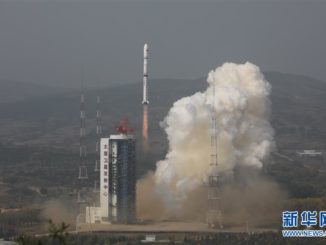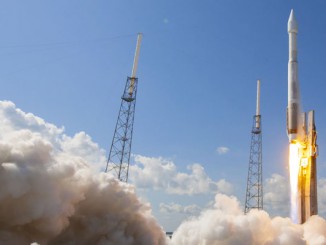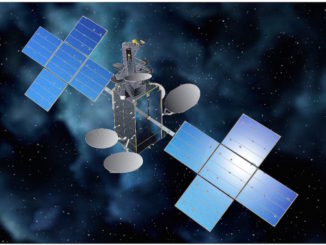EDITOR’S NOTE: Updated July 14 with launch delay.

The UAE’s Hope mission is set for liftoff this week from Japan, taking aim on Mars with a package of scientific instruments designed to probe weather and climate change on the Red Planet.
About the size of a Mini Cooper, the nearly 3,000-pound (1,350-kilogram) spacecraft is set to embark on a seven-month journey to Mars. If it reaches its destination, the mission will become the first from the Arab world to enter orbit around another planet.
“The identity of the mission is not just about the UAE, it’s also for the Arab world,” said Omran Sharaf, project director for the Emirates Mars Mission from the Mohammed Bin Rashid Space Center in Dubai. “It’s supposed to inspire the Arab youth, and send a message of hope to them.”
The UAE government first announced plans for the Emirates Mars Mission –also known as Hope, or Al Amal — in July 2014. The government-funded project was designed, built, tested and readied for launch in less than six years, and on a budget of roughly $200 million, a fraction of the cost of NASA’s Mars orbiters.
The spacecraft and its three scientific payloads were developed as a collaborative project between scientists at the Mohammed Bin Rashid Space Center, the UAE Space Agency, and three universities in the United States.
The spacecraft was assembled by Emirati and U.S. engineers at the Laboratory for Atmospheric and Space Physics at the University of Colorado at Boulder. Scientists from Arizona State University and the University of California, Berkeley, also contributed to developing the mission’s scientific instruments.
“International collaboration, especially in a scientific mission, is critical,” Sharaf said in a pre-launch interview with Spaceflight Now. “So we have parts that have been developed in the UAE, we have parts that have been developed in the U.S., and have parts that have been developed in Canada, in Spain, in Europe, that are actually within the mission itself.”
The UAE’s government set the nation on a course for a Mars mission by outlining several objectives, including inspiration for Arab youth, revitalizing the UAE’s high-tech sector, introducing a culture for research and development, and aligning the mission’s arrival at Mars with the 50th anniversary of the country’s independence in 2021.
“Usually, missions that are sent to Mars take a long time and cost more because redundancy is important,” Sharaf said. “In our case, our philosophy was simplicity was important. So instead of crowding our spacecraft with a lot of instruments, we decided to focus on specific questions and address a specific set of questions.”
Emirati engineers worked alongside teams in Colorado to design and build the Hope spacecraft, collaborating and learning from veteran aerospace engineers who have worked on numerous interplanetary missions. In the future, the UAE could pursue more ambitious interplanetary probes, and do more of the work on its own.
The training aspect of the Hope mission is similar to the way Emirati engineers worked with a South Korean company to build the DubaiSat 1 and 2 Earth-imaging satellites, which launched in 2009 and 2013. Using lessons learned from that experience, UAE teams took on more responsibility in building the KhalifaSat Earth observation satellite that launched in 2018.
The UAE’s first astronaut, Hazzaa Ali Almansoori, flew to the International Space Station on a nearly eight-day mission last year.
The country’s burgeoning space program is geared toward helping the UAE foster a “post-oil economy,” Sharaf said.
“So that’s why they went with a Mars shot,” he said. “They wanted to create an ecosystem that supports the creation of an advanced science and technology sector. The other thing that the UAE wanted to do is it wanted to prepare future scientists and engineers in the UAE that eventually would be able to address our national challenges, which are mainly focused around water resources, food resources, and clean energy.”

Sharaf has helped guide the UAE’s space program since 2006, when he joined the Mohammed Bin Rashid Space Center after graduating from the University of Virginia with a bachelor’s degree in electrical engineering. During his time working in South Korea for the DubaiSat missions, Sharaf earned a master’s degree from the Korea Institute of Science and Technology.
After the DubaiSat experience, the UAE’s leadership decided to aim for a more distant frontier.
“The direction for the government was to build it, don’t buy it,” Sharaf said of the Emirates Mars Mission. “Work with others, learn from others, don’t start from scratch. Start where others ended, so complement their work. However, you need to build it, you’re not going to buy it. Obviously, there is going to be risk associated with that, especially since it’s the first mission we’ve built that goes to Mars.”
Pete Withnell, a program manager at LASP who worked on the Emirates Mars Mission, said it was an “ideal choice” for UAE officials to reach out to experts at U.S. research institutes to help develop the Mars orbiter. After all, he said, universities are made to transfer knowledge.
“Perhaps the most visible part of this mission is a spacecraft, and instruments, and a journey to Mars, and an important scientific endeavor to happen there,” Withnell said in a virtual media briefing before the launch. “That’s all inside of this greater purpose of creating the knowledge economy, and creating a program which used knowledge transfer as its driving mechanisms.”
More than 450 people worked on the Emirates Mars Mission, according to Sharaf. About 200 members of the team have come from the UAE, and about 150 people from LASP in Colorado have worked on the project. Of the 200 Emiratis assigned to the mission, more than a third have been women, Sharaf said.
“The very fabric that a university is made out of is one based on education, teaching, mentorship, and indeed, collaboration,” Withnell said. “So these concepts were not only familiar to us, but it was our very nature to participate in this program in the way that the original founders and visionaries of this program required.”
“I would say the beginning of the program six years ago, there was no blueprint,” Withnell said. “There was no plan that existed how to go about organizing this type of collaboration for a deep space mission.
“There certainly are many space endeavors that, indeed, are international,” Withnell said. “What you’ll find is that Country A made a specific part, and Country B made another part, and those two parts then came together, great international efforts in and of themselves. But that’s not what happened here. This is two teams coming together as one, and merging and working together as one team on the building of the spacecraft, of the instruments, of the overall mission.”
NASA Administrator Jim Bridenstine said in June that the UAE’s advancements in space exploration could lay the groundwork for further international cooperation.
“I’m very excited about the United Arab Emirates, and their Hope mission,” Bridenstine said. “We have done a lot to support them, and they want to be big supporters of ours in the Artemis (moon landing) program.
“Countries that historically have not been exploration countries are stepping up, and not just talking about it, but backing it up with budgets,” Bridenstine said. “So all of this is going to be very helpful for us as we move forward. NASA is an institution that is a tool of diplomacy, and there is no better diplomacy than exploring our own solar system together, and eventually the rest of our galaxy and the universe.”
The Emirates Mars Mission team’s approach to building the probe involved some risk-taking. And there’s the inherent risk of sending a mission to Mars. Around half of the robotic missions ever sent to the Red Planet have failed.
“For the Emirates, it’s more about the journey, it’s more about the impact,” Sharaf said. “Reaching there is one of the goals, but that doesn’t mean that that the mission has failed if we didn’t manage to get there. So is failure an option? Yes, it is an option. Because as long as we learn and we move forward, it’s just a setback.”
Sharaf said mission designers did not add redundancy into ever major system on the spacecraft. That would cost more money, taken more time, made the probe’s construction and testing more complex, and made the spacecraft heavier.
“Our approach and philosophy was we’re not going to have redundancy for everything,” Sharaf said. “We’re going to have selective redundancy.
Creating backups in every segment of the spacecraft “would increase the cost, it would increase the duration, and it would definitely, exponentially, increase the complexity because having a double-redundant or a triple-redundant system is much more difficult to verify than a selectively redundant one.”

The Emirates Mars Mission will rocket into space aboard a Japanese H-2A launcher from the Tanegashima Space Center in southern Japan.
Liftoff is scheduled for 5:58 p.m. EDT (2158 GMT) Sunday, or 6:58 a.m. Monday in Japan, five days later than originally planned. Officials called off a launch attempt Tuesday due to poor weather at Tanegashima.
In the hours before liftoff, ground crews from Mitsubishi Heavy Industries, which was contracted by UAE officials to perform the launch, will transfer the 174-foot-tall (53-meter) H-2A rocket to its launch pad at Tanegashima on a rocky perch overlooking the Pacific Ocean.
Once filled with super-cold liquid hydrogen and liquid oxygen propellants, the H-2A will light its main engine and two solid rocket boosters to vault away from Tanegashima and arc downrange over the Pacific Ocean, riding 1.4 million pounds of thrust.
The H-2A’s two strap-on boosters will burn out and jettison less than two minutes into the mission, followed by separation of the rocket’s aerodynamic payload shroud roughly four minutes after liftoff.
The first stage will shut down its main engine and drop away to fall into the Pacific Ocean more than six-and-a-half minutes into the flight, followed by two burns by the H-2A’s hydrogen-fueled upper stage to first place the Hope probe into a parking orbit around Earth, then accelerate the spacecraft to a velocity of more than 21,000 mph (34,000 kilometers per hour).
The H-2A will deploy the probe around an hour after taking off from Tanegashima. The spacecraft will extend its power-generating solar panels around five minutes later, then begin transmitting signals to ground controllers in Dubai through a NASA tracking station in Spain.
Around 90 minutes after liftoff, the spacecraft will activate rocket thrusters to begin controlling its orientation. One of the first priorities after launch is to point the solar panels toward the sun to begin producing electricity.
The first in a series of course correction maneuvers is planned in August, beginning a process of fine-tuning the Hope probe’s trajectory toward Mars. Eventually, navigators on Earth will guide the spacecraft toward a precise aimpoint near the Red Planet, comparable to an archer hitting 2-millimeter target from a kilometer away, according to Withnell.
A 30-minute firing by the Hope probe’s engines will steer the spacecraft into orbit around Mars in early February, completing a 306 million-mile (493-million kilometer) interplanetary journey. The maneuver to enter orbit at Mars is one of the riskiest phases of the mission, Sharaf said.
The probe’s preliminary arrival date at Mars is Feb. 9, but that could be adjusted, depending on the date when the mission actually leaves Earth, Sharaf told Spaceflight Now.
After swinging into an initial capture orbit next February, the Hope spacecraft will maneuver into an operational science orbit around April 2021 that ranges between approximately 12,400 miles (20,000 kilometers) and 26,700 miles (43,000 kilometers) above Mars.
During parts of each 55-hour orbit, the spacecraft’s move at roughly the same speed around Mars as the planet’s rotation. That will give the orbiter’s science instruments sustained views of the same region of Mars.
The Hope mission will pursue many of the same science objectives as NASA’s Mars Atmosphere and Volatile Evolution, or MAVEN, spacecraft. MAVEN arrived at the Red Planet in 2014.
Scientists have analyzed data from the MAVEN mission to confirm that the bombardment of the solar wind and radiation stripped away the Martian atmosphere, transforming the planet from a warmer, wetter world into the barren planet of today.
The Hope probe will track oxygen and hydrogen escaping from the Martian atmosphere into space, and will peer deeper into the planet’s atmosphere than MAVEN. Scientists want to investigate possible links between Martian weather and climate with the escape of atmospheric particles.
“We focus on three primary objectives,” said Sarah Al Amiri, the lead scientist for the Emirates Mars Mission and the UAE’s minister of state for advanced sciences. “The first is to characterize the weather system of Mars throughout an entire year, and more importantly fill in the gap of the day-to-night transitions within the weather of Mars.
“We also look at how far out hydrogen and oxygen extend into space. That gives us an understanding of how far out it gets, and provides a better understanding of atmospheric escape,” she said.
One of the tasks of the science team will be “linking the two objectives together, characterizing changes within the lower atmosphere, so if there’s a dust storm on Mars, or changes in temperature, how does that impact rates of atmospheric escape, and particularly escape of hydrogen and oxygen from the outer atmosphere.
A color camera on the mission was developed by LASP at the University of Colorado at Boulder and MBRSC. Infrared and ultraviolet spectrometers were produced by LASP, Arizona State University and the University of California, Berkeley, in partnership with Emirati scientists.
“It is a weather satellite, and that’s one objective of the mission,” Al Amiri told Spaceflight Now in a recent interview. “We have the correlation. So we also look at what role Mars’s weather plays in atmospheric loss. That’s the other part of the mission.”
The sensors will scan the Martian atmosphere, joining a fleet of NASA, European Space Agency and Indian spacecraft currently operating at the Red Planet.
Al Amiri said scientific data from the Hope mission will be released publicly beginning in September 2021.
Email the author.
Follow Stephen Clark on Twitter: @StephenClark1.



